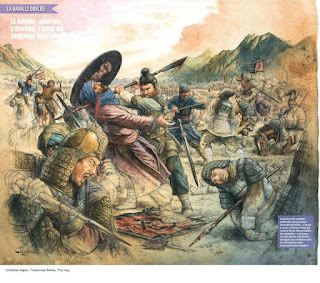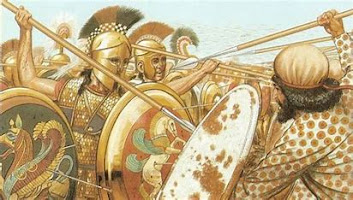The Battle of Thermopylae (480 BC)
Introduction:
The Battle of
Thermopylae, fought in 480 BC between the Persian Empire and a small coalition
of Greek city-states, has become one of the most celebrated and enduring
examples of courage and sacrifice in military history. Despite the eventual
defeat of the Greeks, their resistance against the overwhelming Persian army
under the leadership of King Xerxes serves as a symbol of resistance against
tyranny and oppression, and has inspired countless individuals and movements
throughout history. In this essay, we will explore the historical context, the
events leading up to the battle, the tactics and strategies employed by both
sides, and the lasting impact of the battle on Western culture, military
strategy, and political ideology.
Historical
Context:
To fully
understand the significance of the Battle of Thermopylae, it is necessary to
examine the historical context in which it took place. The Persian Empire,
under the rule of King Xerxes, had been expanding its territory for several
decades, conquering vast regions of Asia and Africa. In 492 BC, Xerxes’ father,
Darius I, had attempted to invade Greece, but was defeated by the Athenians and
their allies at the Battle of Marathon. Xerxes was determined to avenge this
defeat and expand his empire further westward.
In 480 BC,
Xerxes assembled a massive army of over 100,00zfrom all corners of the Persian
Events Leading
up to the Battle:
The Persian army
advanced through northern Greece, sacking cities and leaving destruction in its
wake. The Greeks, however, were not idle. They had formed a coalition of
city-states, led by Athens and Sparta, and were preparing to meet the Persian
invasion. The Greek army, commanded by the Spartan king Leonidas, marched to
Thermopylae, a narrow pass through which the Persian army would have to pass in
order to reach southern Greece.
The Greeks knew
that they were heavily outnumbered, and their tactics reflected this. The pass
at Thermopylae was only wide enough for a few soldiers to pass at a time, which
made it an ideal location for the Greeks to make a stand. They built a wall of
shields and positioned themselves in a narrow corridor, where their superior training
and tactics could be fully utilized.
Tactics and
Strategies:
The Persian army
arrived at Thermopylae in late August or early September, and began to attack
the Greek defenders. The Persian soldiers, however, were not trained for the
kind of fighting that the Greeks employed. The Greeks used their long spears to
deadly effect, stabbing at the Persians as they tried to force their way
through the narrow pass. The Persian cavalry, which was useless in the narrow
confines of the pass, was unable to break through the Greek line.
Despite their
initial successes, the Persian army was unable to dislodge the Greek defenders
from their position. On the second day of the battle, a Greek traitor named
Ephialtes showed the Persians a mountain path that could be used to bypass the
Greek position. Leonidas realized that his army was in danger of being
surrounded, and ordered the majority of his soldiers to withdraw. He and a
small group of Spartans remained behind to cover their retreat and continue the
fight.
The final phase
of the battle saw the Persian launch
a massive assault on the remaining Greek defenders. The Spartans fought with
unparalleled bravery and discipline, using their superior training and tactics
to offset the Persian numerical advantage. The Greeks fought to the last man,
with Leonidas himself being killed in the final assault.
Impact on Western Culture:
The impact of the Battle of Thermopylae on
Western culture has been significant. The Greeks, despite their eventual
defeat, had demonstrated that a small, disciplined army could hold its own
against a larger, less organized force. This lesson has been heeded by military
strategists throughout history, from the Roman legions to modern special forces
units. The concept of a small, elite force defending a narrow choke point
against overwhelming odds has become a staple of military lore, and the
Spartans at Thermopylae are celebrated as the archetypal example of this
strategy.
The battle has also become a symbol of
resistance against tyranny and oppression. The Persian Empire, with its vast
armies and autocratic rule, represented the antithesis of the democratic ideals
that the Greeks held dear. The Greeks at Thermopylae fought not just for their
own survival, but for the preservation of their way of life and their political
freedoms. This spirit of resistance against tyranny has been invoked by
countless political movements throughout history, from the American Revolution
to the Arab Spring.
The Battle of Thermopylae has also had a
significant impact on Western literature and popular culture. The story of the
300 Spartans has been retold countless times, in everything from epic poems to
Hollywood blockbusters. The image of the brave, outnumbered defenders holding
the line against overwhelming odds has become a cultural touchstone,
representing courage and determination in the face of adversity. The legacy of
the battle can be seen in everything from the works of Shakespeare to the
superhero movies of today.
Conclusion:
The Battle of Thermopylae, fought in 480 BC
between the Persian Empire and a small coalition of Greek city-states, has had
a lasting impact on Western culture, military strategy, and political ideology.
Despite their eventual defeat, the Greeks at Thermopylae demonstrated the power
of discipline and organization against overwhelming odds, and their sacrifice
has become a symbol of resistance against tyranny and oppression. The battle
has inspired countless individuals and movements throughout history, and its
legacy can still be felt in literature, film, and popular culture today.


